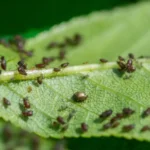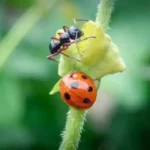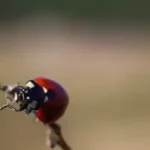Imagine strolling through your garden, enjoying the peacefulness. You’re checking out your flowers and plants, remembering how hard you’ve worked to make this place special, and you can see it in every petal and leaf. Suddenly, you feel something sticky on one of the leaves you touch. When you look closer, you see that some leaves have turned yellow and spot a mealybug. As a backyard gardener, I get that you don’t want to use harmful chemicals to address issues like this, and you’re probably wondering, is there a natural way to keep these bothersome mealybugs away? For example, do ladybugs eat mealybugs?
Ladybugs are natural mealybug hunters who eat them at all life stages. From larvae to adulthood, ladybugs are always hungry for small-scale insects and soft-bodied pests like mealybugs, reducing their numbers effectively. Ladybirds provide continuous protection against pest problems in your garden.

Before I knew any better, I used to swat ladybugs until I learned they are great pals for gardeners. These little speckled wonders bring a pop of color to your landscape and a voracious appetite for mealybugs that munch on your plants, which can seriously damage your backyard.
Although there are many natural pest control methods growers can apply to their backyard garden, in this article, I’ll share insights on how these tiny red and black speckled heroes act as protectors for your garden.
Humble Highlights
- Discover these 5 key benefits of the humble ladybug and how their species targets and controls mealybug populations so you can help protect your garden effectively and naturally!
- Save time by understanding various additional beneficial insects that aid ladybird beetles in their efforts to combat mealybug infestations in your backyard garden so you can keep your plants healthy, grow more crops, and help the surrounding environment.
- Explore these 5 additional easy and natural methods to keep mealybugs away from your garden so you’re well-armed against these pesky invaders!
Why Use Ladybugs As Pest Control In The Garden
Ladybugs, ladybirds, or ladybeetles are tiny heroes that help protect your vegetation. They’re great for your gardening toolkit because they truly do some fantastic things on your behalf.
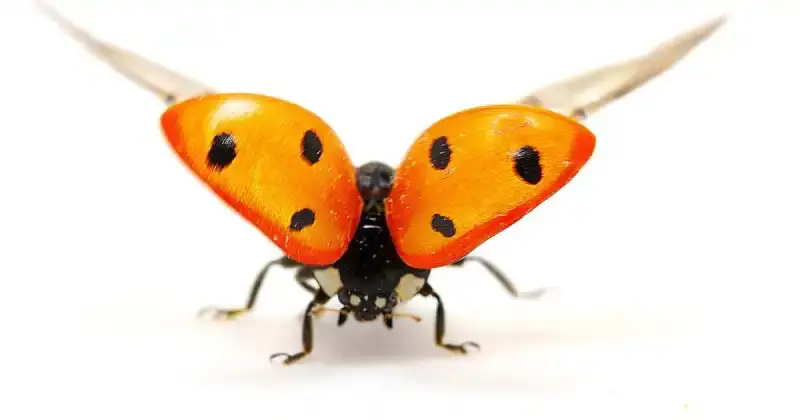
1. Ladybugs consume nasty bugs: Ladybugs exhibit a voracious appetite for soft-bodied pests like aphids, spider mites, and mealybugs, acting as efficient pest-hunting machines.
2. They’re suitable for plants: Unlike strong chemicals that can be harsh and damaging to your plants, ladybugs are gentle. They’re a safe and friendly way to keep bad bugs away.
3. Nature stays balanced: Ladybugs help your garden stay healthy by ensuring there aren’t too many detrimental bugs crawling around your green space. This means your plants stay happy and focus on growing large and abundant harvests each season. 1
4. They’re cute: Ladybugs look cute! They bring a touch of endearing charm to your garden aesthetics, effortlessly fulfilling their role as both functional and delightful garden inhabitants
5. Easy to have around: Although not always guaranteed, once ladybugs come to your garden, they may stick around so long as there are enough pests to munch on, water to drink, and shelter to use.
To attract ladybugs into your garden, grow flowers like marigolds, daisies, and fennel. These blooming varieties provide pollen and nectar, making your green space a welcoming spot for these helpful insects.
Mealybug And Their Impact In The Garden
Mealybugs are one of the most common pests you can find in the backyard or greenhouses. But like many other pests, they’re easier to deal with when caught early. These little pests are easily identified with their light gray bodies covered in white hairs. They form a cottony mass around themselves and often gather around the plant’s crown, where the stem meets the root of a plant.

Mealybugs can come from various sources, such as contaminated soil or vegetation you’ve inspected before bringing them home. So, watching the flowers you bring or purchase from local plant shops or garden centers is crucial. 2
Although small, dealing with mealybugs can be a grower’s nightmare. Plants infested with mealybugs are severely weakened and produce less as these tiny bugs suck the life out of your plants. They can cause leaves to yellow, wilt, and eventually drop prematurely. While chemicals might seem the only answer to saving your precious crops, mealybugs are challenging because of their protective waxy covering. This problem gets even trickier in crowded plant areas where it’s hard to reach and remove them.
Do Ladybugs Eat Mealybugs
Ladybugs, or lady beetles, are voracious predators that can be vital in controlling mealybug populations. While their diet isn’t limited solely to mealybugs, these little insects are definitely on the menu for these speckled bugs.
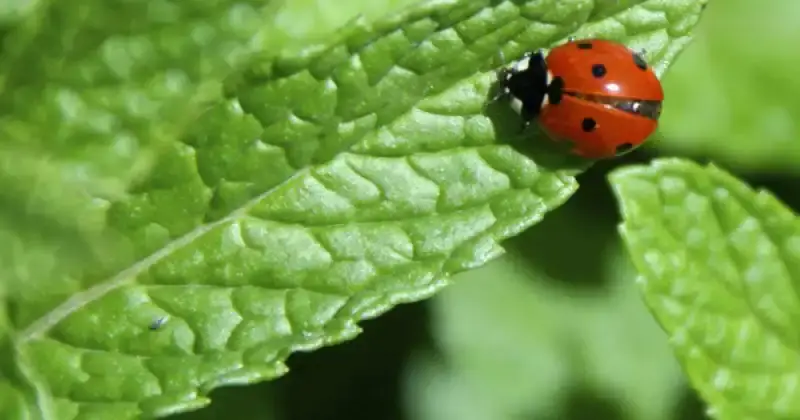
Ladybugs are attracted to mealybugs due to their sugary excretion, known as honeydew. Mealybugs produce this sticky substance as they feed on plant sap, and ladybugs find it quite irresistible. Fortunately, this attraction to honeydew brings ladybugs closer to the source of one of their favorite snacks – mealybugs. 3
When ladybugs encounter mealybugs, they go into full-on predator mode. They use their specialized mouthparts to grasp and chew up their prey. Interestingly, ladybugs also highly tolerate mealybug waxy coatings, which might deter other predators. This tolerance gives them a competitive edge in hunting mealybugs even when their cottony covering protects them.
While ladybugs can effectively control mealybugs, their impact may vary depending on the scale of the infestation and the overall ecosystem balance. In some cases, introducing ladybugs can significantly reduce mealybug numbers, which benefits your plants and the overall health of your garden.
When you introduce ladybugs to your garden, do it in the evening when it’s cooler, as they’re more likely to seek shelter and stay. It’s also best to give your plants a light water mist before releasing them, providing your new garden friends with a quick and refreshing drink.
Lady Beetle Species That Prey On Mealybugs
When dealing with mealybugs, different predators step in to help. Interestingly, some focus just on mealybugs, while others are generalists that feed on any small, soft-bodied insects. Here are the most common ladybird varieties that enjoy eating mealybugs.
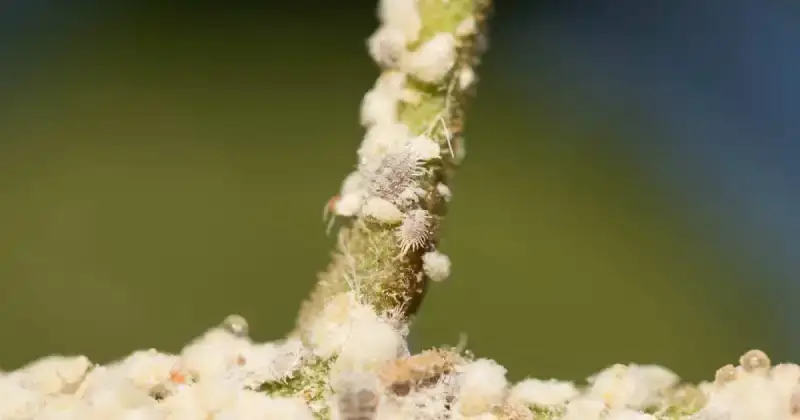
Mealybug Destroyer
One of the most prominent mealybug predators is the Cryptolaemus montrouzieri Mulsant, commonly known as the mealybug destroyer. This beetle originated in Australia and has earned its reputation as a formidable adversary against mealybug populations. 4
Notably, both the adult mealybug destroyer and their larvae engage in mealybug hunting, making it a dual-strike force against these pests. An adult female mealybug destroyer can lay up to 500 eggs during her lifetime.
Interestingly, the mealybug destroyer larvae exhibit a clever mimicry strategy. They resemble mealybugs by sporting wax-like filaments that parallel the appearance of their prey. This wax camouflage serves a dual purpose as it helps them blend into the mealybug colony and minimizes interference from mealybug-tending ants.
This adaptation gives the larvae a tactical advantage, allowing them to move about and feed on mealybugs with reduced disruption. However, as effective as the mealybug destroyer is, it faces limitations, particularly in colder regions. The predator’s vulnerability to low winter temperatures, as observed in some greenhouses, can impact its population and efficiency as a mealybug control agent.

Scymninae Subfamily
The subfamily Scymninae houses several species that target mealybugs. Hyperaspis, Nephus (Scymnobius), and Scymnus are prime examples of these mealybug-hungry beetles. These species are also similar to mealybugs due to their wax-covered bodies, which can lead to misidentification, often mistaking them for the mealybug destroyer.
Coccinellinae Subfamily
Migratory lady beetles from the Coccinellinae subfamily are keenly interested in mealybug infestations and the subsequent honeydew they produce. Notable examples include the convergent ladybeetle and the transverse ladybird beetle. These lady beetles are attracted to substantial mealybug populations, drawn by the alluring scent of honeydew, a byproduct of mealybug feeding.
Ladybug Allies: Beneficial Insects That Prey On Mealybugs
Aside from ladybugs, mealybugs have a bunch of other enemies in the wild. Here are some of the beneficial insects that target mealybugs in the garden.
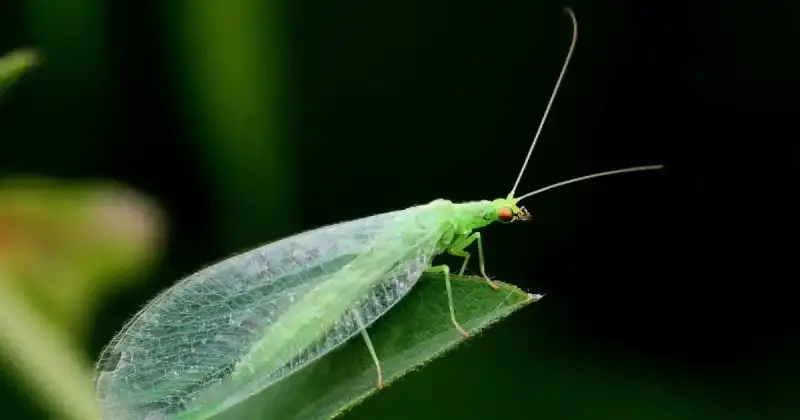
Lacewings
Some lacewings, especially Chrysoperla carnea, are famous for going after mealybugs. In fact, Chrysoperla carnea was one of the pioneers in demonstrating its ability to suppress mealybug populations. And while lacewing adults are beneficial, their larvae become formidable predators targeting mealybugs, nymphs, and eggs.
But here’s the twist: the lacewing larvae might have a tough time when it comes to mealybug eggs, hidden and cozy in their waxy sack. The waxy secretion acts like armor, making it harder for the lacewing to snack on the eggs. Additionally, bigger mealybugs have a secret weapon. They release a special fluid that helps keep predators away. 5
Now, while Chrysoperla carnea gets a lot of attention, there are other lacewings too. Some might not be as famous, but they’re still part of this bug-eat-bug world, helping keep mealybugs in check and helping your garden’s ecosystem remain balanced.
Predaceous Midges
Another group that takes on mealybugs is predaceous midges, also known as cecidomyiid flies. These flies are often overlooked, and we only know a little about their effect on mealybug numbers in most places. However, there are a few interesting stories. For example, Diadiplosis koebelei cut down mealybugs by about 30% in New Zealand vineyards. Different midges are connected to mealybugs in various places.
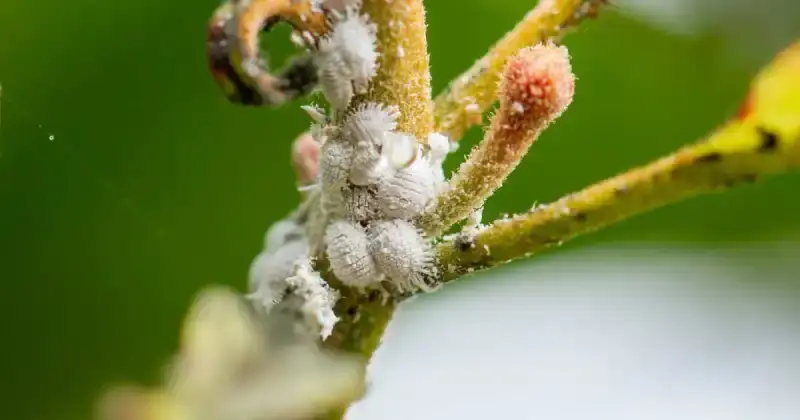
Here’s how it works: the grown-up fly, not interested in being a predator, lays eggs in or around the mealybug ovisac. When the eggs hatch, the larvae look like maggots. They’re picky eaters and mainly snack on mealybug eggs and tiny larvae. However, when they’re done munching, they enter the pupal stage underground and turn into the next generation of flies.
Anagyrus Vladimiri
The parasitic wasp known as Anagyrus holds a notable reputation for its role as an effective natural biological control of mealybugs. What sets Anagyrus apart is its sophisticated strategy that targets various developmental stages of mealybugs.
The wasp actively looks for mealybugs to catch, and when it finds one, it stings the mealybug to stop it from moving. But that’s not all. The wasp subsequently puts an egg inside the mealybug. 6
After that, something exciting happens. The mealybug changes into what’s like a tough, brown shell. Inside, the baby wasp grows. When it’s ready, the adult wasp breaks out through a hole in the back of the shell, and the new adult wasp is ready to find a partner and start the process all over again.
Remember, the same mealybug treatment applied to your plants outside can also effectively work on indoor ones, including ladybugs. Be sure to catch any bug issues early as the best treatment is prevention.
Beyond Ladybugs: Other Natural Methods Against Mealybugs
Neem Oil
Neem oil is an effective natural solution to control mealybugs due to its multifaceted properties. It acts as an insect growth regulator, disrupting the development and reproduction of mealybugs. Neem oil also contains compounds that smother and suffocate adult mealybugs, larvae, and eggs by forming a barrier on their bodies, limiting their movement and feeding ability.
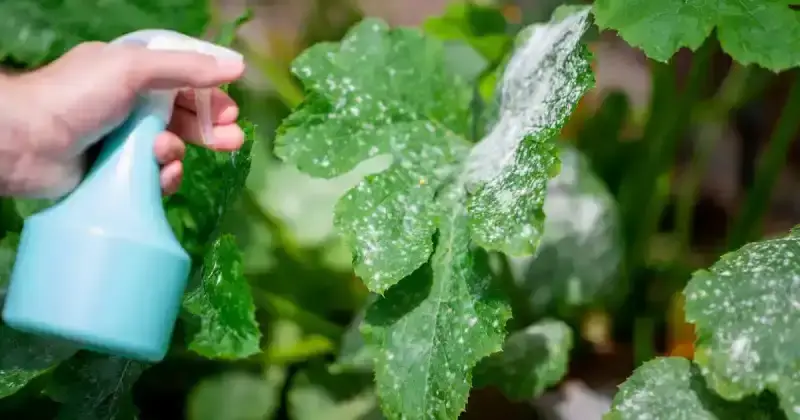
Moreover, Neem oil has antifeedant properties that deter mealybugs from feeding on treated plants. By applying the oil regularly, typically every 7 to 10 days, infestations can be suppressed and mealybug populations reduced, contributing to the overall management and control of these pests. 7
Avoid applying Neem oil directly under the scorching sun. The oil can act like a magnifying glass, amplifying the sun’s heat and potentially harming the leaves. The best time to apply the oil to plants is in the early morning or late afternoon, preferably when the temperature is cooler, and the sun is not as intense.
Pruning
Pruning those affected branches is an effective solution for localized infestations where mealybugs or aphids are concentrated at the tips of branches. Carefully remove and dispose of the infested parts, preventing the pests from spreading further throughout your garden.

Bug Blaster Method
Using a strong jet of water to dislodge the pests from the plants is known as the bug blaster method. This method is particularly effective for light infestations that haven’t had a chance to develop fully. However, be cautious if you see ants around the pests, as they might return them to the plant.
Alcohol
Rubbing alcohol, specifically 70% isopropyl alcohol, can kill mealybugs and aphids on contact. You can dip a cotton swab in rubbing alcohol and wipe the pests or dilute rubbing alcohol with water in a 1:1 ratio and spray the solution on the plants.
Diatomaceous Earth
Diatomaceous earth powder works by physically damaging the exoskeleton of insects, causing them to dehydrate and eventually die. To use diatomaceous earth powder, lightly sprinkle or dust it onto the affected plants and their surrounding soil. Once applied, the powder clings to the pests, creating microscopic abrasions on their bodies that lead to their eventual demise. 8
This method is particularly effective against soft-bodied insects like mealybugs and aphids, which are vulnerable to the abrasive action of the powder.

Conclusion
Ladybugs are highly beneficial insects that help to keep other harmful insect populations in check. The larvae of these beetles feed primarily on aphids and mealybugs, making them an essential ally for those trying to protect their plants from pests without chemical pesticides or herbicides. And they bring a cute charm, too.
But ladybugs aren’t alone in the fight. Lacewings and parasitic wasps also join forces against these pests. By teaming up with these friendly bugs, you’re giving your plants a strong defense for a happy and thriving garden.
Have you treated your garden for mealybugs? What successful method did you use? Perhaps it’s one we’ve mentioned here or an entirely different technique. Drop us a line in the comments below and spill!
SOURCES
- Michigan State University, AgBioResearch – Increasing Predator-Friendly Land Can Help Farmers Reduce Costs
- The National Gardening Association – Pest Control Library: Mealybugs
- National Library Of Medicine, National Center For Biotechnology Information – Intraguild Interactions Between The Mealybus Predators Cryptolaemus Montrouzieri And Chrysoperla Carnea
- Wikipedia – Mealybug
- Department Of Primary Industries – Cryptolaemus And Lacewings For Mealybug And Scale Control
- Wikipedia – Anagyrus
- University Of California Agriculture & Natural Resources – Pests Of Homes, Structures, People, And Pets: Mealybugs
- University Of Wisconsin-Madison, Division Of Extension – Mealybugs



